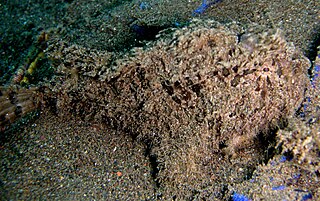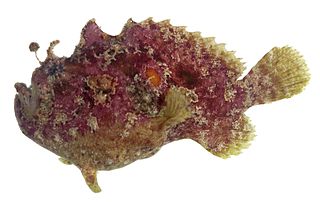
Frogfishes are any member of the anglerfish family Antennariidae, of the order Lophiiformes. Antennariids are known as anglerfish in Australia, where the term "frogfish" refers to members of the unrelated family Batrachoididae. Frogfishes are found in almost all tropical and subtropical oceans and seas around the world, the primary exception being the Mediterranean Sea.

The sargassum fish, anglerfish, or frog fish is a species of marine ray-finned fish belonging to the family Antennariidae, the frogfishes, the only species in the genus Histrio. It lives among Sargassum seaweed which floats in subtropical oceans. The scientific name comes from the Latin histrio meaning a stage player or actor and refers to the fish's feeding behaviour.

The ocellated frogfish is a species of marine ray-finned fish belonging to the family Antennariidae, the frogfishes. This fish is found in the Western Atlantic Ocean.

The striated frogfish or hairy frogfish is a species of marine ray-finned fish belonging to the family Antennariidae, the frogfishes. This species is found in the Indo-Pacific and eastern Atlantic Ocean.

Commerson's frogfish or the giant frogfish, Antennarius commerson,, is a species of euryhaline ray-finned fish belonging to the family Antennariidae, the frogfishes. This fish is found in the Indo-Pacific region.
Lophichthys boschmai, also known as Arafura frogfish or Boschma's frogfish, is a species of anglerfishes closely related to frogfish. L. boschmai is the only species in the Lophichthydae family. L. boschmai were first reported by Marinus Boseman in 1964 to the Rijksmuseum van Natuurlijke Historie, now known as National Museum of Natural History in Leiden. The species was named after Dutch zoologist, Hildbrand Boschma.

The warty frogfish or clown frogfish is a species of marine ray-finned fish belonging to the family Antennariidae, the frogfishes. The warty frogfish is found in the Indo-Pacific region.

Histiophryne bougainvilli, commonly known as the Smooth Anglerfish, is a frogfish found in the waters of Queensland, New South Wales, and Western Australia. There are an estimated 40 specimens known.

Histiophryne is a genus of frogfishes found in waters ranging from Taiwan to South Australia. There are currently five known species. These fishes are easily distinguished from other anglerfishes as having a reduced luring appendage, a highly evolved form of the first dorsal fin spine.

The Butler's frogfish or blackspot anglerfish, Tathicarpus butleri, is a rare species of frogfish in the family Antennariidae. The only member of its genus, this species is the most derived member of its family and represents a separate lineage from all other frogfishes, leading to some consideration of it being placed in its own family. It is found off the southern coast of New Guinea, and along the coasts of Western Australia to 33° S latitude, the Northern Territory, and Queensland to 22° S latitude. A benthic species, it inhabits inshore tropical waters and coral reefs to a maximum depth of 145 m (476 ft), though most are found shallower than 45 m (148 ft). Its specific epithet is after its discoverer Dr. Graham Butler.
David J. Hall is an underwater wildlife photographer, author, and naturalist. His photographs have appeared in hundreds of books, magazines, calendars, and other print media worldwide, including National Geographic, Smithsonian, Natural History, Sierra, Time, Science, Scientific American, Geo, Terre Sauvage, and BBC Wildlife. He is the recipient of many awards, including first place in two categories of the BBC Wildlife Photographer of the Year, first place in both the Nature's Best and Sierra magazine competitions, and third place in the Festival Mondial de l'Image Sous-Marine. He is also the recipient of an award from the International Institute for Species Exploration, for research leading to his co-authorship of the description of Histiophryne psychedelica, Psychedelic Frogfish, and generally considered to be one of the ten most significant new species described in 2009.

Nudiantennarius is a monospecific genus of marine ray-finned fish belonging to the family Antennariidae, the frogfishes. The only species in the genus is Nudiantennarius subteres, the deepwater frogfish. This fish is found in the Western Pacific Ocean.

The shaggy frogfish, also known as the hispid frogfish, shaggy anglerfish or zebra anglerfish, is a marine ray-finned fish belonging to the family Antennariidae, the frogfishes. This fish is found in the Indo-Pacific.

The painted frogfish, or spotted frogfish, black angler or painted anglerfish is a species of marine ray-finned fish belonging to the family Antennariidae, the frogfishes. This species is found in the Indo-Pacific region.

Abantennarius sanguineus, the bloody frogfish or sanguine frogfish, is a species of marine ray-finned fish belonging to the family Antennariidae, the frogfishes. The sanguine frogfish is found in the eastern Pacific Ocean.
Abantennarius drombus, freckled frogfish or Hawaiian freckled frogfish, is a species of marine ray-finned fish belonging to the family Antennariidae, the frogfishes. The freckled frogfish is endemic to the Hawaiian Islands.

Abantennarius coccineus, the scarlet or freckled frogfish, is a species of frogfish originally classified as Chironectes coccineus and Antennarius coccineus. It lives within tropical waters and has a central distribution being around Indo-East-Pacific areas- excluding Hawaii. The habitat of the scarlet frogfish is in the shallow zones of the ocean. It is found within reef areas, in rocky mounds or sponges where there are places for it to hide amongst from predators. The scarlet frogfish comes in a variety of colours, from tan and brown colours to bright reds and yellows and will grow to a maximum length of 13 centimetres (5.1 in). It can be identified taxonomically through its pectoral rays, the presence of dark patches that appear on its fins and body, along with its lack of distinctive tail base. The scarlet frogfish is not harmful to humans and is not caught by fisheries for consumption purposes, however it has been caught previously for studies relating to the abundance of reef-dwelling fish and as bycatch of shrimp trawling. Similar to other frogfish species, the scarlet frogfish is a predatory carnivore and exhibits a low degree of sociality, only interacting with other scarlet frogfish during their mating period.

Rhycherus filamentosus, commonly known as the tasselled anglerfish, is a species of frogfish endemic to southern Australia in the southwestern Pacific Ocean and southeastern Indian Ocean. It is a well-camouflaged predator and lies in wait on the seabed for unwary prey to approach too close.

Antennatus tuberosus, the tuberculate anglerfish, pygmy angler, pygmy frogfish or tuberculated frogfish, is a species of marine ray-finned fish belonging to the family Antennariidae, the frogfishes. This fish is found in the Indian and Pacific Oceans.

Abantennarius is a genus of marine ray-finned fishes belonging to the family Antennariidae, the frogfishes. The fishes in the genus are found in the Indian, Pacific and, one species, in the Western Atlantic Oceans.






















